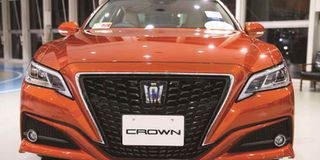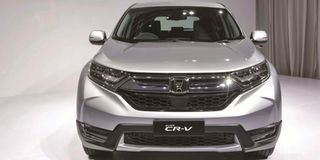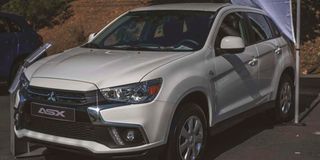
Think of defensive driving as enhanced awareness by training.
| FotosearchDN2
Premium
Is defensive driving recommended for every driver?
What you need to know:
- If there is a country seriously in need of defensive driving classes, it is this one.
- We can't wait in line, we can't wait to finish (or even start) driving school, we can't wait for our driving licenses.
Baraza,
You have mentioned defensive driving a couple of times in your column – just how important is it? Is it recommended for every driver?
What does it involve, and where can one learn this kind of driving? How long does it take?
How much does it cost, and is one given a special license for it if you'd want to apply for a driver's job?
Hello,
Defensive driving is not really necessary, generally speaking, especially with the looming advent of level 5 AV (autonomous vehicle) self-driving technology. The role of the driver is about to become redundant soon.
However, this is Kenya we are talking about - where not only are we still a galaxy away from self-driving cars, the human operations are still languishing in proficiency somewhere between early man and gibbering gibbons. If there is a country seriously in need of defensive driving classes, it is this one.
Or not.
We wouldn't need defensive driving if we adhered to traffic regulations and practice what they taught us at the driving school.
However, we are a country of angry, impatient people. We can't wait in line, we can't wait to finish (or even start) driving school, we can't wait for our driving licenses, so we take shortcuts and flout rules without compunction occupying road space here in Kenya is an extreme sport.
This is where defensive driving comes in. Over and above the standard curriculum of road signs, angle parking and how to move a vehicle, defensive driving empowers its disciples to practice compensatory manoeuvres against the hotheads mentioned in the paragraph above.
Think of it as enhanced awareness by training, but it doesn't end there. The concept also compensates for adverse driving conditions such as poor weather.
This means that the course is extremely vital in vehicle maintenance and road safety and, therefore, comes highly recommended for all drivers. It entails, in a nutshell, the following:
- Planning ahead
- Vehicular control, especially speed
- Anticipatory reactions, especially to other drivers. This also means one shouldn't expect the other drivers to behave predictably.
- Respect for fellow road users.
- Situational awareness by always having a 360-degree mental picture of your current circumstances.
- Avoiding distractions when driving; distractions such s cell phone use, eating, reading.
There are several defensive driving schools around the country. Still, we do not do recommendations in this column on principle and the rules of fair/unfair competitive advantages, but a quick Google search will yield a number of results from which you can take your pick.
The course duration will depend on the lesson plan you go for, as will the cost. It is dependent on who is teaching you the course.
There is no special license awarded to successful students of defensive driving. Still, since it is taught in schools/academies, these institutions may or may not issue certificates of completion.
They will most likely give you this piece of paper, which you can then use as a credential for your advanced driving skill when looking for a job.
Toyota Crown Hybrid or Nissan Skyline GT350?
Dear JM,
I am an ardent follower of your columns. Kudos for the informative work. I am looking forward to owning a Toyota Crown Hybrid or Nissan Skyline GT350.
I am completely lost on the choice to make, and here I implore your in-depth motoring and the review of these two brands in shaping the final choice.
NB: Relatively both YOM 2014-2015.
Regards,
Justus
Hi Justus (nice name there),
Do you want a hybrid? Do you really want a hybrid? What happens when the hybrid drive packs up? Yes, the Crown is a Toyota, known to be bullet-proof, but there are things called "unforeseen eventualities". Then what?
That makes the GT350 (I'm pretty sure this is a Ford Mustang and not a Nissan Skyline. The Nissan should be a 350GT. Syntax lives matter) the more obvious choice here. It has heritage - ask any petrol head what the Nissan Skyline badge portends; it has the looks- unusual, yes, but in a world of seven billion and social media where everyone wants to stand out, sometimes driving a unique car may be all the satisfaction you can ever hope to get on that front; and with the VQ35 block - it is the Vq35, is it not? - sportiness is on the menu.
The car is named after a sports car line and packs an engine from another sports car: the 350Z Fairlady. The credentials are not bad at all.

Toyota Crown
But it's a Nissan. This is the phrase that triggers all sorts of accusations about brand bias, but the 350GT is a Nissan. Someone once told me the side mirror of a Skyline costs Sh22,000; I don't know how true this is because I've never had to shop for a Skyline side mirror, and secondly, that was several years back; perhaps we should factor in inflation, you reckon?
You could go for a regular non-hybrid Crown if you are the type that plays it safe. Solid Toyota reliability right there, and for some reason, the prices drop drastically once they land here and start straying into second Kenyan owner territory.
I've seen examples changing hands for as little as 600 large (avoid), or more commonly, 800 - 900 (more like it). Despite their zeitgeist bent, I'm still uneasy about used hybrids, so maybe you want to hold back a little on the hybrid Crown.
Personal choice
The surprise of the day comes down to personal choice. I'd pick the Skyline over the Crown if I had to (I don't), but that's because I'm not that smart, and I love to drive.
The Skyline is a 4-door GTR sans turbo; that 3.5 litre V6 howls like nothing you have heard before; the rear-drive platform is a joy to chuck around if you possess the necessary skills and get one with a black interior.
The thick-rimmed steering wheel with its Infiniti-derived boss makes you think you are in an Infiniti G35, which is a 2-door Skyline sold in the US some years ago, and the car does go like an Infiniti.
The sheer joy of helmsmanship may justify the running costs if you think like me; after all, you are talking to someone who bought a twin-turbo Subaru Legacy and a BMW E34 with more than 300,000km on the clock - cars nobody in their right mind would recommend.
They emptied my piggy bank, but I do not regret a single gear shift, or a single rpm, or a single litre of fuel I put into either of their tanks...
***
Clarification: The Skyline 350GT line I am referring to spans the V36 and V37 platforms. Incidentally, the V37 350GT is a hybrid, just like the Crown you are looking for; in which case cast your net further upstream for the 3.7 litre 370GT. It has the engine from the 370Z.
The V35, despite its Infiniti DNA, is getting on a bit in age now, and, ahem, being a Nissan, examples on sale may not be in excellent shape. Go for newer models from the V36 and V37 platforms.
Help me choose between an RVR and a CRV
I own a Mitsubishi RVR, which I have driven for three years. I want to upgrade to a CRV kindly would like a review on the CRV.
Kind regards,
Cynthia
Hi Cynthia,
What model of CRV are you planning to upgrade to? If it is the latest one, then, as you may have noticed from previous instalments of Car Clinic, that is a pending matter.
If it is an earlier model, then it depends on which one since there is a bit of variation in specification from one model to the next. Just to put a bit of perspective on how wide a variation we are talking about: the first model back in the mid-90s could be bought with a functional showerhead as Honda answered a question nobody asked.
In a more realistic submission to market dynamics, contemporary models (from the immediately previous one) can be had with seven seats, an upgrade from previous models, which were limited to only five. You can now understand why I need you to specify which exact model of CRV you want: the self-contained one or the one aimed at the prolific and highly fertile?
That being said, there are some common themes that traverse the entire lineup. First up is the general lack of offense in the design language. CRVs are not bland, but they don't break new ground in aesthetics either. They play it safe, which is what their target market likes.

In the theme of playing it safe, Honda engines are among the most reliable, including the high-revving VTEC iterations and the fancy-sounding i-VTEC derivatives. They offer good economy, somewhat, and good performance, somewhat.
What is not reliable is the multilink rear suspension. It's good for comfort and good for handling - and the self-adjusting camber has had many wondering if their vehicle is broken after people trailing them observed that the vehicles were looking a little knock-kneed from the back.
Don't panic, they're designed like that. It's when the road disappears that problems arise, and a lot of Kenyans are familiar with the concept of disappearing roads. You see, the name betrays itself: multilink. This means "many links", which in turn means many joints.

Joints are points of weakness in any mechanical system - they are where breakages occur if breakages are due. Rough roads are a good source of breakages, that needs no explanation. Drive a CRV through rough roads on the regular and see how hard you regret it.
That being said, there really isn't much else wrong with a CRV. The downsides are: off-pace safety features compared to rivals, the seven-seater is expensive and the five-seater comes with a roof-mounted centre seatbelt for the back row, which can be fiddly, cumbersome and unsightly.
However, you get a solid and refined engine, excellent, sporty handling and road-holding, ample cargo space, optimised ergonomics and a powered tailgate, maybe. As far as value for money goes, it earns four stars out of five. It's not a bad buy.





